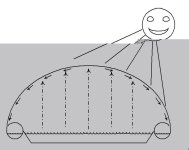MitchJi
10 MW
Hi,
http://blogs.discovermagazine.com/8...et-from-global-warming-turn-the-sahara-green/
ScienceNOW Daily News:
http://blogs.discovermagazine.com/8...et-from-global-warming-turn-the-sahara-green/
To Save the Planet From Global Warming, Turn the Sahara Green
A team of researchers has come up with a simple plan to halt global warming: All we need to do is turn both the Sahara and the Australian outback into vast, shady forests.
While that might sound so ambitious as to be absurd, the climate scientists say the project would be no more expensive or technologically challenging than some of the other geoengineering schemes that are currently under discussion. And researcher Leonard Ornstein says it would certainly get results. Ornstein says that if most of the Sahara and Australian outback were planted with fast-growing trees like eucalyptus, the forests could draw down about 8 billion tons of carbon a year–nearly as much as people emit from burning fossil fuels and forests today. As the forests matured, they could continue taking up this much carbon for decades [ScienceNOW Daily News].
The study, published in the journal Climatic Change, proposes huge desalinization plants on the North African and Australian coastlines to convert sea water to fresh water, and a system of aqueducts and pumps to move the water inland. The young forests would be nourished with drip irrigation to prevent water loss through evaporation, and the sandy wastelands would chang into endless groves of heat-tolerant, tropical trees like eucalyptus. All that water engineering would come at a steep price–about $2 trillion per year–but the researchers say that cost isn’t much more than the projected cost of capturing all the carbon dioxide emissions from the world’s power plants and burying them deep underground. They also note that carbon capture and storage technology is still untested on the commercial scale, while everyone already knows that forests work as carbon sponges.
But like other proposed geoengineering schemes, the researchers note that planting these forests might have side effects. The increased moisture could trigger plagues of locusts in Africa, just as the odd wet year does now. It could also dampen existing soils, stopping iron-rich dust from blowing off the Sahara and into the Atlantic Ocean, where it nourishes sea life, the study points out [ScienceNOW Daily News].
ScienceNOW Daily News:
Forest a Desert, Cool the World
By Mason Inman
ScienceNOW Daily News
14 September 2009
For more than a century, a few scientists have occasionally daydreamed of transforming much of the Sahara desert green, with a lush inland sea or vast tracts of farmland. Now researchers say they have actually found a way to make such a scheme work with forests across the desert--and to slow climate change in the process.
The idea is the brainchild of Leonard Ornstein, a cell biologist at the Mount Sinai School of Medicine, who partnered with climate modelers David Rind and Igor Aleinov of NASA's Goddard Institute for Space Studies, all in New York City. They envision desalinating seawater from the neighboring oceans and bringing it inland using aqueducts and pumps. Drip irrigation--plastic tubing to water the trees' roots--would minimize the amount of water lost to evaporation and seepage into sandy soils, allowing trees to prosper in areas that are parched today.
According to climate simulations to be published next month in the journal Climatic Change, the forests would cool the Sahara by up to 8°C in some areas. "Eucalyptus grandis and a large number of other tropical tree species are heat-tolerant, so long as they have an ample supply of water in the root zone," Ornstein says. The tree cover would also bring more rain--about 700 to 1200 millimeters per year--and clouds, which help reflect the sun's rays back into space. The scheme could also work for the arid Australian outback, the team reports.
Ornstein says that if most of the Sahara and Australian outback were planted with fast-growing trees like eucalyptus, the forests could draw down about 8 billion tons of carbon a year--nearly as much as people emit from burning fossil fuels and forests today. As the forests matured, they could continue taking up this much carbon for decades.
The project wouldn't be cheap. Adding up the costs for building, running, and maintaining reverse-osmosis plants for desalination and the irrigation equipment, the researchers put the price tag at some $2 trillion per year. The price would be roughly comparable to that of capturing carbon dioxide at power plants and storing it underground, which would eventually cost about $200 per ton of carbon, according to a recent study from Harvard University's Belfer Center for Science and International Affairs, compared with about $400 per ton of carbon for the forests. "Any solution to climate change has to be a multitrillion-dollar project," Ornstein says. "The issue is what the payback is." In several decades, the forests could be sustainably harvested as a source of fuel for wood-burning power plants, making them a nearly carbon-neutral energy source, Ornstein argues.
Planting these forests might have side effects. The increased moisture could trigger plagues of locusts in Africa, just as the odd wet year does now. It could also dampen existing soils, stopping iron-rich dust from blowing off the Sahara and into the Atlantic Ocean, where it nourishes sea life, the study points out.
Despite the drawbacks, the proposal "is incredibly important and definitely worth taking seriously and looking into further," says atmospheric scientist Richard Anthes, president of the University Corporation for Atmospheric Research in Boulder, Colorado. "The benefits could be enormous and go well beyond carbon sequestration," making vast areas far more livable and productive. The key issue is whether desalinating enough seawater would be affordable, Anthes adds. "This paper suggests that it is."



